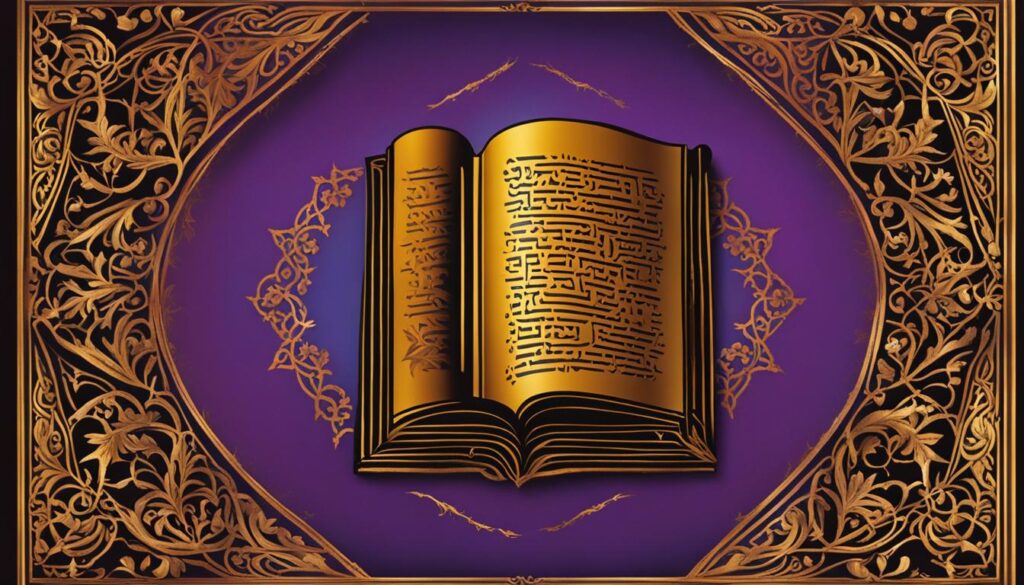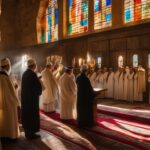Judaism, one of the oldest religions in the world, has a deep-rooted tradition of prayer practices that reflect its rich history and beliefs. From monotheism to the significance of the Torah, Jewish prayer rituals offer a unique and profound spiritual experience. In this article, we will delve into the various aspects of Jewish prayer practices, exploring their origins, customs, and importance in the lives of Jewish individuals and communities.
Key Takeaways:
- Judaism has a rich history rooted in the covenant between God and Abraham, the Israelites’ journey, and the Diaspora.
- Monotheism is central to Jewish worship and prayer rituals.
- The Torah serves as the central sacred text in Judaism, providing guidance and wisdom.
- Jewish prayer practices are influenced by a variety of sacred texts, including the Tanakh, Talmud, Mishnah, and Midrash.
- There are different branches of Judaism, each with its own unique prayer customs and traditions.
By exploring the prayer practices of Judaism, we gain a deeper understanding of the spiritual richness and depth of the Jewish faith, as well as the values and beliefs that shape the lives of Jewish individuals and communities.
The Importance of Monotheism and God’s Presence in Jewish Prayer
Judaism is a monotheistic religion, centered on the belief in one God who is singular and undivided. This fundamental principle shapes the prayer customs and rituals of the Jewish people, infusing their worship with profound meaning and spiritual significance. In Judaism, prayer is not just a religious duty; it is a way to establish a personal connection with God and acknowledge His presence in every aspect of life.
Meaningful prayer in Judaism involves recognizing and appreciating God’s presence in the world. Jews are encouraged to cultivate a deep awareness of the divine that surrounds them, whether through observing nature, studying sacred texts, or engaging in acts of kindness. This recognition of God’s presence influences the way prayers are structured and the intentions behind them. Each prayer in the Jewish liturgy serves as an opportunity to express gratitude, seek guidance, and connect with the divine.
“Prayer is not asking. It is a longing of the soul. It is daily admission of one’s weakness. It is better in prayer to have a heart without words than words without a heart.” – Rabbi Abraham Joshua Heschel
Throughout history, Jewish prayer customs have evolved, but the core belief in God’s presence remains constant. The act of prayer is not solely confined to designated times or places. Instead, it is a continuous practice, with Jews finding inspiration and connection to the divine in their daily lives. By acknowledging God’s presence in their prayers, Jews aspire to live a life imbued with spiritual purpose, seeking to align their thoughts, words, and actions with the divine will.
Understanding the importance of monotheism and God’s presence in Jewish prayer provides insights into the rich and meaningful traditions of Judaism. It offers a glimpse into the profound spiritual connections that Jews seek to cultivate through their prayers, leading to a deeper understanding of the Jewish faith as a whole.
| Key Points | Details |
|---|---|
| Monotheism | The belief in one singular and undivided God is central to Jewish prayers. |
| God’s Presence | Jews strive to recognize and acknowledge God’s presence in their everyday lives. |
| Meaningful Connection | Prayer provides an opportunity to establish a personal connection with the divine. |
| Continuous Practice | Jewish prayer is not confined to specific times or places; it is a continuous practice. |
The Significance of the Torah in Jewish Prayer Practices
In the rich tapestry of Jewish prayer practices, the Torah holds a position of paramount importance. Considered the central sacred text in Judaism, the Torah encompasses the laws and teachings that guide every aspect of Jewish life. Divided into the Five Books of Moses, it outlines the commandments and laws that Jews are expected to follow in their daily lives. The Torah serves as the foundation of halakha (Jewish law) and tradition, shaping the beliefs and practices of Jews worldwide.
Through the study and application of the Torah, Jews find spiritual meaning and guidance in their prayer practices. The verses and stories within the Torah are infused with deep symbolism and timeless wisdom, providing a framework for understanding and connecting with the divine. By engaging with the text, Jews are able to deepen their understanding of their relationship with God and their place in the world.
The Role of the Torah in Shaping Jewish Prayer
The Torah plays a crucial role in shaping the content and structure of Jewish prayer. The liturgy of Jewish prayers often includes excerpts from the Torah, such as passages from the Psalms, the Book of Proverbs, and the Book of Exodus. These verses are chosen for their spiritual significance and relevance to the theme of the prayer. By incorporating words of the Torah into their prayers, Jews are able to connect with the sacred text and draw inspiration from it.
In addition to influencing the content of prayers, the Torah also guides the timing and frequency of Jewish prayer practices. For example, the daily prayer services are based on the ancient sacrificial offerings that were prescribed in the Torah. The Torah also prescribes specific prayers for special occasions and holidays, such as the Passover Seder and the High Holy Days.
The Torah is a living document that continues to shape the spiritual practices of Judaism today. Through its study, interpretation, and application, Jews are able to deepen their connection with God and their understanding of their faith.

The Role of Jewish Sacred Texts in Prayer
In addition to the Torah, Jewish sacred texts include the Tanakh, Talmud, and other important writings that guide Jewish beliefs and practices. These texts serve as sources of spiritual wisdom, moral guidance, and religious authority, shaping the religious lives of Jews throughout history.
The Tanakh, also known as the Hebrew Bible, comprises the Torah, Prophets, and Writings. It is a foundational text that provides insight into Jewish history, law, and theology. Within the Tanakh, the Torah holds a central position as the divine revelation given to Moses on Mount Sinai. It contains the commandments and laws that Jews are expected to follow, and its study is integral to Jewish prayer practices.
The Talmud is a vast compilation of Jewish teachings and commentaries on Jewish law. Composed of the Mishnah, which is a record of early rabbinic discussions, and the Gemara, which is a commentary on the Mishnah, the Talmud offers a comprehensive framework for understanding and interpreting Jewish law. It provides a wealth of insights and explanations that enhance the depth and meaning of Jewish prayer rituals.
Other important writings, such as the Mishnah and Midrash, further contribute to the understanding of the Torah and other sacred texts. The Mishnah is a collection of oral traditions and rulings that guide Jewish practice, while the Midrash consists of homiletic interpretations and stories that illuminate the biblical texts. These texts, along with a multitude of commentaries and interpretations throughout Jewish history, enrich the spiritual experience of Jewish prayer and provide a rich tapestry of ancient Jewish prayer rituals and techniques.
The Role of the Tanakh in Jewish Prayer Practices
The Tanakh, commonly known as the Hebrew Bible, plays a significant role in Jewish prayer practices. It serves as a foundation for understanding Jewish beliefs, values, and traditions, and provides a framework for interpreting and engaging with the divine.
Within the Tanakh, the Torah is of primary importance. It contains the Five Books of Moses and encompasses the core commandments and laws that guide Jewish life. Jews turn to the Torah for guidance, inspiration, and spiritual sustenance, drawing upon its teachings and stories to infuse their prayers with depth and meaning.
The Prophets and Writings, the other two sections of the Tanakh, offer additional insights and perspectives on Jewish spirituality. The Prophets convey messages from God, addressing moral and ethical issues, while the Writings include poetic and philosophical works that explore the human experience and relationship with the divine.
By engaging with the Tanakh, Jews immerse themselves in the collective wisdom and heritage of their ancestors, deepening their connection to God and enriching their prayer experiences. It is through the sacred texts of Judaism that ancient prayer rituals and techniques continue to be preserved and practiced to this day.
Jewish Prayer and the Talmud
The Talmud, a vast compilation of Jewish teachings and commentaries on Jewish law, plays a crucial role in shaping Jewish prayer practices. It provides a comprehensive and nuanced understanding of the Torah, offering insights and interpretations that enhance the spiritual experience of prayer.
Composed of two main components, the Mishnah and the Gemara, the Talmud represents centuries of scholarly discourse and analysis. The Mishnah is a concise record of early rabbinic discussions and legal rulings, while the Gemara is a commentary on the Mishnah, containing further elaboration, debate, and analysis.
Within the Talmud, numerous tractates and chapters address various aspects of prayer, including the structure of the liturgy, the correct recitation of prayers, and the intention and mindset required during prayer. The Talmudic discussions offer insights into the underlying principles and intentions behind different prayer rituals and provide guidance for observing and practicing them.
By studying and engaging with the Talmud, Jews gain a deeper understanding of the intricate details and nuances of Jewish prayer. The Talmudic wisdom continues to inform and shape prayer practices, ensuring the preservation and transmission of ancient Jewish prayer rituals and techniques.
Understanding the Major Branches of Judaism’s Prayer Practices
Judaism encompasses a diverse range of beliefs and practices within various Jewish denominations. The major branches of Judaism include Orthodox, Conservative, and Reform. Each branch has its own unique beliefs, customs, and approaches to Jewish law and practice, reflecting the rich diversity of the Jewish people.
In Orthodox Judaism, prayer practices are steeped in tradition and adhere strictly to Jewish law. Services are conducted in Hebrew, and men and women are often segregated during prayer. Orthodox Jews prioritize the preservation of ancient rituals and follow a structured liturgy.
Conservative Judaism strikes a balance between tradition and modernity. Prayer services may be conducted in a combination of Hebrew and the vernacular language, and men and women may sit together during prayer. There is more flexibility in interpreting Jewish law, allowing for adaptation to contemporary circumstances while still maintaining a connection to tradition.
Reform Judaism emphasizes individual autonomy in interpreting Jewish teachings and practices. Prayer services may be conducted predominantly in the vernacular, with a focus on personal and communal meaning. Traditional rituals may be modified or omitted in favor of more inclusive and egalitarian practices.
Comparison of Major Branches of Judaism’s Prayer Practices
| Branch | Language | Gender Segregation | Approach to Jewish Law |
|---|---|---|---|
| Orthodox | Hebrew | Segregated | Strict adherence |
| Conservative | Hebrew and Vernacular | Sometimes together | Adaptation with adherence |
| Reform | Vernacular | Often together | Individual interpretation |
Jewish worship practices and prayer rituals vary across the branches of Judaism, reflecting the diverse expressions of faith within the Jewish community. Understanding the differences between Orthodox, Conservative, and Reform Judaism can provide valuable insights into the intricate tapestry of Jewish prayer practices and the ways in which they shape the spiritual lives of individuals and communities.
Conclusion
Jewish prayer practices are deeply rooted in the rich history, beliefs, and traditions of Judaism. Monotheism, the belief in one God, is central to the spiritual lives of Jews, providing a foundation for their prayer rituals. Through their prayers, Jews seek to acknowledge and connect with the divine presence that surrounds them, infusing their lives with spiritual meaning and purpose.
The Torah, the central sacred text in Judaism, serves as a guide for prayer practices. It contains the laws and teachings that shape Jewish life, and its study and application bring spiritual guidance to Jews worldwide. In addition to the Torah, other Jewish sacred texts like the Tanakh and the Talmud offer further insights and understanding of the Jewish faith, enriching the practice of prayer.
Within the diverse branches of Judaism, including Orthodox, Conservative, and Reform, there is a shared commitment to prayer as a spiritual practice. These branches may have different beliefs, customs, and approaches to Jewish law, but they all recognize the importance of prayer in nurturing the soul and fostering a connection with God.
By exploring the spiritual practices in Judaism, individuals can gain a deeper appreciation for the ancient Jewish prayer rituals and the profound depth of the Jewish faith. Through prayer, Jews continue to honor their rich traditions and strengthen their relationship with the divine.
FAQ
What are the essential tenets of Jewish faith?
The essential tenets of Jewish faith encompass one God, Torah, and a special relationship with Him. Monotheism is central to worship and prayer rituals.
What is the significance of the Torah in Jewish prayer practices?
The Torah is the central sacred text in Judaism, containing the laws and teachings that guide Jewish life. It serves as the foundation of Jewish law and tradition, shaping the beliefs and practices of Jews worldwide.
What other sacred texts are important in Judaism?
In addition to the Torah, Jewish sacred texts include the Tanakh, Talmud, Mishnah, Midrash, and other writings that guide Jewish beliefs and practices. These texts serve as sources of spiritual wisdom, moral guidance, and religious authority.
What are the major branches of Judaism?
The major branches of Judaism include Orthodox, Conservative, and Reform. Each branch has its own unique beliefs, customs, and approaches to Jewish law and practice.
What is the significance of prayer in Judaism?
Prayer is a central spiritual practice in Judaism. It reflects the belief in one God and the unique relationship between God and the Jewish people. Prayer rituals are deeply rooted in the rich history, beliefs, and traditions of Judaism.









